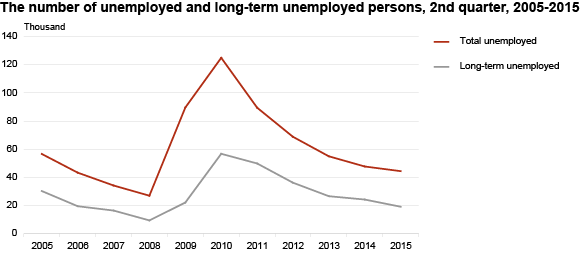Long-term unemployment has significantly decreased
The number of unemployed persons changed very little compared to the first quarter and was estimated at 44,400.
Compared to 2nd quarter of 2014, the number of unemployed persons decreased approximately by 3000. As the number of short-term unemployed persons increased slightly compared to the same quarter of the previous year, the decrease in the number of long-term unemployed persons played a bigger role here. Among unemployed persons, poverty risk is the highest among the long-term unemployed, i.e. unemployed persons who have been seeking work for at least 12 months. A longer period without work will devalue a person’s human capital gained through previous work and education, and the person may lose the habit of working. Employers can also be rather sceptical about the working abilities of the long-term unemployed. In the 2nd quarter of 2015, there were approximately 19,200 persons who had been seeking work for more than 12 months.
While unemployment was characterized by a moderate trend of decline, employment increased moderately. Employment rate increased compared to both the 2nd quarter of 2014 and the 1st quarter of 2015 by more than 1 percentage point and was 65.1% in the 2nd quarter of 2015. The number of employed persons increased to approximately 640,000. The increase in the number of employed persons was not only caused by the decrease in unemployment but also by an increase in activity on the labour market. Young people influenced this increase in activity the most. In the 2nd quarter of 2015, the employment rate of 15–24-year-olds increased by nearly 5 percentage points and reached 44% compared to the same quarter of the previous year. One reason for this was the increase in the share of young people in the age where they are more likely to enter the labour market. It can be also said that the increase in youth activity on the labour market compensated for their declining overall number.
In the 2nd quarter of 2015, compared to same quarter of the previous year, the number of persons who could potentially be active on the labour market had diminished by approximately more than 7000. In the 1st quarter, labour force participation rate was the highest that it had been in 15 years in quarterly comparison. The same could be said about the 2nd quarter of 2015, when labour market participation rate of 15–74-year olds was slightly under 70%. In other words, 69.6% of the working-age population was active on the labour market either as seeking work or working. The increased activity helped to decrease the influence of overall declining numbers of working-age population. Moreover, compared to the 2nd quarter of 2014, the number of persons who were active on the labour market increased roughly as much as the number of working-age persons decreased (by more than 7,000 persons).
The unemployment rate is the share of the unemployed in the labour force (the sum of employed and unemployed persons). The employment rate is the share of the employed in the working-age population (aged 15–74). The labour force participation rate shows the share of the labour force in the population aged 15–74. The estimates are based on the data of the Labour Force Survey.
Statistics Estonia has been conducting the Labour Force Survey since 1995 and every quarter 5,000 persons participate in the survey. The Labour Force Survey is carried out by statistical organisations in all the European Union Member States on the basis of a harmonised methodology.
